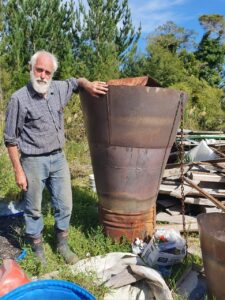
Kev “from waste to black gold.”
OrganicNZ Magazine – July/August 2023
Biochar: The soil improver that could solve the problem.
Kev Dowman tells Paula Sharp why we should be producing biochar on a commercial scale. He says it is an investment for our future, specifically, the future of New Zealand’s land quality and how we can contain carbon.
Globally, there is scientific investment going into producing biochar, an activated type of charcoal, because of its environmental upside. And the upside is potentially massive. Biochar has the ability to hold carbon in the soil for thousands of years and simultaneously increase land fertility. Kevin Dowman is passionate for New Zealand to play a big part in his movement.
Kev is tapping into his experience and knowledge of logging and logging practices (milling wood, farming, and commercial waste products) to create biochar for domestic and commercial use. The process involves wood (or woodchip, garden waste, cardboard, or bones) heated to around 500oC with limited oxygen until it forms a charcoal, then dousing with in liquid, thereby activating the charcoal and creating biochar.
This stabilises carbon (carbon sequestration). Biochar is about 70 percent carbon, the remaining 30 percent is a composite of nitrogen, hydrogen and oxygen. Biochar is so porous it can interact with its surroundings. Research has proven that using biochar to increase soil carbon also increases soil pH and biodiversity, soil water retention and water quality improve, crop yield doubles, land fertility increases, there is less land erosion, microbials are more active (less disease), livestock health improves – therefore human health improves, and climate mitigation is in play. Biochar is so efficient at storing carbon (in a world where we are looking to cut greenhouse gases (GHG)), that it is being hailed as ‘black gold’ by product developers and innovators around the world.
Why is Kev so keen on biochar?
Kev’s journey into biochar was rather oblique. When he was 10 years old, Kev started skipping school to go logging with his father. By 14 he’d all but quit school to be a logger. By 19 he was helping to clear farms of their forestry then he joined Kinleith Pulp and Paper Mill in Tokoroa in charge of his own logging gang. In those days, logging was a hugely lucrative business with whole native forests being cleared and planted in pine, then cleared again. Kev worked the length and breadth of New Zealand, he saw the change from under-scrubbing (slashing the undergrowth) with machetes before felling trees with axes and a (singular) chainsaw, to the use of a version of agent orange (245T) to kill off the scrub before the trees were levelled with machinery. (He has memories of his crew working as the chemical was dropped, their clothes and vehicles covered in its residue. “We were told it was safe, they were using this type of thing in the Vietnam war.”).
Fast forward to 2019, things ‘weren’t quite right’ with his health. Kev was on his way to the doctor but was delayed by school students protesting against climate change. ‘We have 12 years left’ [to stop climate change] was the message he heard. Kev didn’t know if he had 12 years left. But he wanted a solution for these young people. Kev is a father, a grandfather, a man who has worked (and damaged) the land and a man who deeply loves the land. And he is not one to shy away from a challenge. In that moment he decided; ‘I’ve got to do something to change this. These kids need a future.’
Kev is an intelligent and articulate man who never went to university. His white hair and tanned face speak of decades outside. Self-educated on biochar, today he has a high level of technical knowledge on the subject. To meet him, he is more than ‘a man who can’, he is ‘a man who does.’
Kev’s thought process kept coming back to ‘nature knows how to do this’. His bright blue eyes sparkle as he explains; “Nature, by way of photosynthesis, converts carbon gases into solid carbon (plants and trees). As they grow, they are a natural carbon store. (A tree or plant is considered carbon neutral when it reaches maturity). The gas converted in this process is now stored within the tree as wood and plant fibre. Carbon remains in this state until it begins to breakdown, by natural or other means. Insects, decay, burning, and weathering, break down the carbon and release the gases back into the atmosphere.”
Unless it is stabilised; “Over billions of years carbon has formed in a solid state, trapped under ground, in the sea, lakes, swamps, bogs, and even in permafrost, in the form of coal, oil, natural gas and peat. In short, nature takes carbon from the air and puts it in the ground.
“It is well known that wood burned in a non-oxygen environment produces charcoal. Once activated, charcoal is very difficult to break down and carbon in this form can be stored for thousands of years.”
Kev’s solution was simple, if we take it out, we help put it back.
Five years on and many proto-types of biochar furnaces (the Tin Man, the Jolly Rodger, the Kon-Tiki and the Retort Kiln), Kev has built his own energy and time-efficient kiln in order to make biochar for domestic use (copywrite pending). With investment, it is something that could also be upscaled for commercial use. Kev uses a variety of techniques for different materials in order to create biochar, but at the moment, he recommends the bucket style Kon-Tiki for domestic use. His advice to the home gardener is; “No matter what system; Retort, Kon-Tiki, Pit or other, the drier the material, the better – under 20 percent moisture content is ideal. This means, less energy is wasted driving off moisture, allowing for higher temperatures to be reached in the process, resulting in better char. All systems used should have a double burning ability of gases, at higher temperatures to keep down GHG.”
He knows New Zealand is an ideal country to utilise this on a large scale. There is simply a lot of waste wood (and other materials). He is not alone in this; Professor Jim Jones and his team at Massey University see the value of using slash to create biochar on a commercial scale. As a nation we produce a lot of slash which enter the water ways – damaging bridges, making rivers dangerous, damming small water reservoirs and washing up in large quantities on our beaches as logs or smaller driftwood. Recent weather events have seen huge amounts of damage caused by slash. Moreover, vast quantities of non-commercial grade logs are left in our remote forests, out of (public) sight, out of (the industry’s) mind. This wood currently has no commercial value, but could be a resource for biochar?

Kev Dowman & the Kon-Tiki Kiln
Future potential
Kev sees a future where slash or logging refuse is used as fuel for biochar, to harness CO2 as a resource for land quality. That low-grade waste logs could be made into biochar on location to replenish the soil, creating forest fertility. Brazil has already implemented this by switching from a slash and burn protocol to a slash and char technique to reduce its deforestation and CO2 emissions.
Globally, historic over-farming, monoculture, and chemical use, has meant our soil is lacking in available micro and macro nutrients. Kev and other experts know biochar, mixed with organic matter, can alter this. When nitrogen leaches below the plant root zone, biochar holds nitrate/nitrogen in the correct place. Biochar increases the cations (positively charged ions within the soil) and anions (negatively charged ions). Higher levels of cations provide potassium, ammonium, magnesium, calcium, zinc, manganese, iron and copper to the plant. On the flip side, anions allow for higher amounts of nitrate, phosphate, sulphate, borate and molybdate. When biochar is present, plants preform and absorb to a higher standard. Biochar in our water ways could act as natural carbon filters; key to New Zealand being able to clean up its lakes, rivers and streams.
Kev says cattle grazed on carbon rich land cannot produce hydrogen in their rumen, therefore they cannot produce methane in their flatulence, a part of our carbon emissions issue. Research is also proving biochar as a feed additive could reduce methane production in the cow’s rumen. This benefit to our meat and dairy industry could be vast. In 2025, He Waka Eke Noa, the Primary Sector Climate Action Partnership plans to implement taxes on farmed animal’s methane and CO2 emissions. This tax will be the farmers responsibility (and therefore passed ono the consumer). Instead of taxing emissions in this way, perhaps He Waka Eke Noa, could support farmers to change their methane and CO2 levels at ‘grass roots’? Independently, and as a collective, farmers given this information and access to biochar or biochar furnaces could be incentivised to change their farming practices, producing less animal gases. Australian farmer, Doug Pow found (and published) that by adding biochar to feed, livestock showed improved nutritional intake therefore increased milk production, and less odour and gas. As an aside, Kevin also questions whether our bee population is being ‘carbon starved’, that by introducing biochar into our pastures our bees would thrive at a higher level?
Biochar is not new to the world. Evidence of its use has been found in the Amazon between 500-9000 years BP (before present) to make arid soil fertile. In 2010, scientists James Hansen and James Lovelock started working with biochar biochar for carbon dioxide removal. Many countries are exploring ways of eliminating or storing carbon. In New Zealand, Manaaki Whenua, Landcare Research, has benchmarked and monitored soil carbon in 275 of its 500 on-farm sites (to June 2022). They are well aware of our carbon resources.
Is biochar a part of the answer?
In 2023, the Wall Street Journal writes that large companies around the world are offsetting their carbon emissions with carbon credits and by buying into biochar and biochar products. In 2018, Fonterra Nelson transitioned from using coal to burning wood in a process called ‘co-firing’ to power its premises. Kev suggests it would be a small step to create biochar in the process. Fonterra, will you lead the way?
Should New Zealand be refocusing its CO2 gaze on options like biochar in order to validate its green credentials? Kev Dowman certainly thinks so and supports the work of Massey University’s Professors Jim Jones and Sarah McLaren of the New Zealand Biochar Research Centre.
Further information: Garden Biochar Production
Making biochar, by Living Web Farms. A six-part series recommended by Kev Dowman. www.youtube.com/watch?v=svNg5w7WY0k
How to make a Retort Kiln www.youtube.com/watch?v=PxrsBQDBQOk
How to make a Kon-Tiki Kiln www.youtube.com/watch?v=1o0QqePtNM4
New Zealand Biochar Research Centre
Author’s bio:
Paula Sharp is a New Zealand Nutritional Therapist interested in organic food production who attended a biochar workshop hosted by Kev Dowman from Awakeri, Bay of Plenty.

